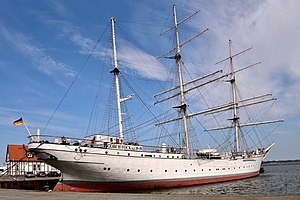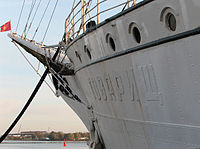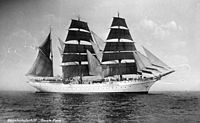
Blohm+Voss (B+V), also written historically as Blohm & Voss, Blohm und Voß etc., is a German shipbuilding and engineering company. Founded in Hamburg in 1877 to specialise in steel-hulled ships, its most famous product was the World War II battleship Bismarck. In the 1930s, its owners established the Hamburger Flugzeugbau aircraft manufacturer which, shortly before the outbreak of World War II, adopted the name of its parent company. Following a difficult period after the war, B+V was revived, changing ownership among several owners, as Thyssen Group and Star Capital. In 2016, it became a subsidiary of Lürssen and continues to supply both the military and civilian markets. It serves two areas – new construction of warships as NVL B.V. & Co. KG, and new construction and refitting of megayachts. The company has been in operation, building ships and other large machinery, almost continuously for 146 years.

The Dar Pomorza is a Polish full-rigged sailing ship built in 1909 which is preserved in Gdynia as a museum ship. She has served as a sail training ship in Germany, France, and Poland. Dar Pomorza won the Cutty Sark Trophy in 1980.

Europa is a steel-hulled barque registered in the Netherlands. Originally she was a German lightship, named Senator Brockes and built in 1911 at the H.C. Stülcken & Sohn shipyard in Hamburg, Germany. Until 1977, she was in use by the German Federal Coast Guard as a lightship on the river Elbe. A Dutchman bought the vessel in 1985 and in 1994 she was fully restored as a barque, a three-mast rigged vessel, and retrofitted for special-purpose sail-training.

Johann Wilhelm Kinau, better known by his pseudonym Gorch Fock, was a German author. Other pseudonyms he used were Jakob Holst and Giorgio Focco.

USCGC Eagle (WIX-327), formerly the Horst Wessel and also known as the Barque Eagle, is a 295-foot (90 m) barque used as a training cutter for future officers of the United States Coast Guard. She is one of only two active commissioned sailing vessels in the United States military today, along with USS Constitution which is ported in Boston Harbor. She is the seventh Coast Guard cutter to bear the name in a line dating back to 1792, including the Revenue Cutter Eagle.

The Flying P-Liners were the sailing ships of the German shipping company F. Laeisz of Hamburg.

The Gorch Fock is a tall ship of the German Navy, built in 1958 as a replacement for the original Gorch Fock built in 1933 which was taken as war reparations by the Soviet Union after World War II, renamed Tovarishch, and returned to Germany in 2003.

Passat is a German four-masted steel barque and one of the Flying P-Liners, the famous sailing ships of the German shipping company F. Laeisz. She is one of the last surviving windjammers.
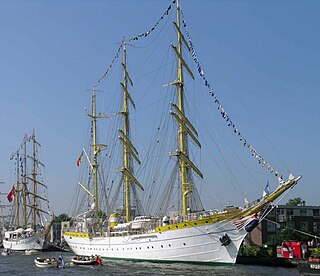
Mircea is a three-masted barque, built in 1938 in Hamburg by the Blohm & Voss shipyard as a training vessel for the Romanian Navy. Her design is based on the successful plans of Gorch Fock; the last of a series of four sister ships. The ship is named after the Wallachian Voivode, Mircea the Elder. After World War II she was temporarily taken over by the USSR, but later returned to Romania. In 1966, she was overhauled by Blohm & Voss.

ARM Cuauhtémoc is a sail training vessel of the Mexican Navy, named for the last Mexica Hueyi Tlatoani Cuauhtémoc who was captured and executed in 1525.

NRP Sagres is a tall ship and school ship of the Portuguese Navy since 1961. As the third ship with this name in the Portuguese Navy, she is sometimes referred to as Sagres III.

SegelschulschiffNiobe was a tall ship used by the Reichsmarine to train cadets and aspiring NCOs. She sank during a white squall on 26 July 1932, with the loss of 69 lives. A memorial monument to Niobe was erected at Gammendorfer Strand on Fehmarn island, within view of the site of the sinking.
USCGC Eagle may refer to:
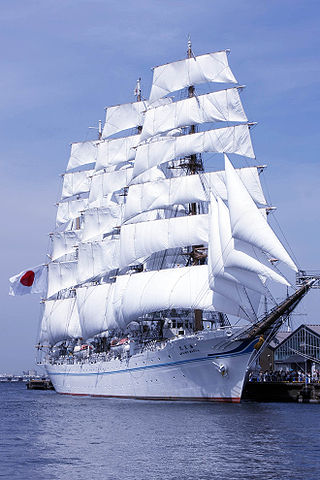
Kaiwo Maru is a Japanese four-masted training barque tall ship. She was built in 1989 to replace a 1930 ship of the same name. She is 110.09 m (361.2 ft) overall, with a beam of 13.80 m (45.3 ft) and a depth of 10.70 m (35.1 ft). She is assessed as 2,556 GT. Propulsion is by two 4-cylinder diesel engines and a total of 2,760 m2 (29,700 sq ft) of sails. The engines have a total power of 3,000 horsepower (2,200 kW) and can propel the ship at a maximum of 14.1 kn, with a normal service maximum of 13 kn. Kaiwo Maru has a range of 9,800 nmi. The four masts are the fore mast, main mast, mizzen mast and jigger mast. The main mast is 43.50 m (142.7 ft). Her complement is 199.

Balmoral is a cruise ship owned and operated by Fred. Olsen Cruise Lines. She was built in 1988 by the Meyer Werft shipyard in Papenburg, West Germany, as Crown Odyssey for Royal Cruise Line. She has also sailed for the Norwegian Cruise Line as Norwegian Crown and Orient Lines as Crown Odyssey. In 2007–2008 she was lengthened by 30 m (98 ft) at the Blohm + Voss shipyard in Hamburg prior to entering service with her current operator.

Guayas is a sail training ship of the Ecuadorian Navy. Launched in 1976, it was named in jointly in honor of Chief Guayas, the Guayas river, and Guayas, the first steamship that was constructed in South America in 1841, and is displayed on the Ecuadorian coat of arms. The ship's home base is Guayaquil, Ecuador.

SMS Niobe was the second member of the ten-ship Gazelle class of light cruisers that were built for the German Kaiserliche Marine in the late 1890s and early 1900s. The Gazelle class was the culmination of earlier unprotected cruiser and aviso designs, combining the best aspects of both types in what became the progenitor of all future light cruisers of the Imperial fleet. Built to be able to serve with the main German fleet and as a colonial cruiser, she was armed with a battery of ten 10.5 cm (4.1 in) guns and a top speed of 21.5 knots. The ship had a long career, serving in all three German navies, along with the Yugoslav and Italian fleets over the span of more than forty years.

ARC Gloria is a three-masted barque. She is a training ship and official flagship of the Colombian Navy.

Monte Pascoal was a Monte-class ocean liner built in 1930 by Blohm & Voss, Hamburg for the Hamburg-Südamerikanische Dampfschifffahrts-Gesellschaft (HSDG). She managed to reach Germany after the outbreak of World War II and was requisitioned by the Kriegsmarine for use as an accommodation ship. She was sunk in 1944 during an Allied air raid on Wilhelmshaven. Subsequently refloated, she was seized by the Allies post war and was scuttled in the Skaggerak with a cargo of gas bombs in 1946.
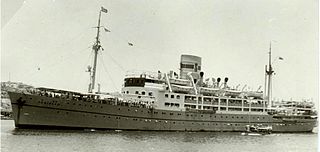
Jagiełło was a medium-sized passenger-cargo ship, sailing under the Polish flag between 1948 and 1949, and then decommissioned due to unprofitable and post-war political conditions, which were not conducive to the development of the Polish passenger fleet, and then transferred to the Soviet Union as Pyotr Velikiy, operating Black Sea passenger services until 1973. The ship had been built by Blohm & Voss for Turkish operators, taken over after completion by the German government. After World War 2 it taken over by the British and then the Soviet Government.
